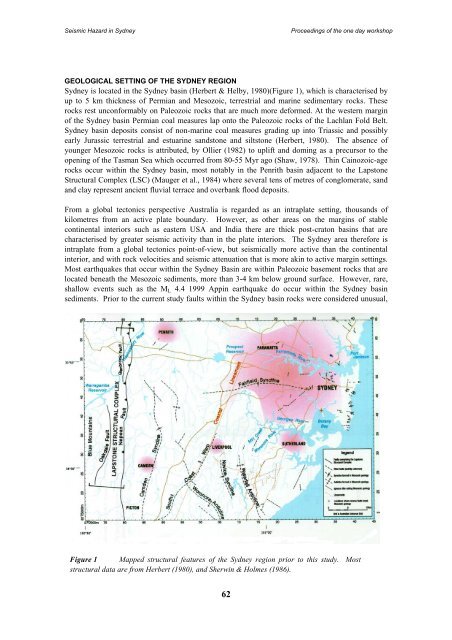Landslides in the Sydney Basin - Geoscience Australia
Landslides in the Sydney Basin - Geoscience Australia
Landslides in the Sydney Basin - Geoscience Australia
- No tags were found...
You also want an ePaper? Increase the reach of your titles
YUMPU automatically turns print PDFs into web optimized ePapers that Google loves.
Seismic Hazard <strong>in</strong> <strong>Sydney</strong>Proceed<strong>in</strong>gs of <strong>the</strong> one day workshopGEOLOGICAL SETTING OF THE SYDNEY REGION<strong>Sydney</strong> is located <strong>in</strong> <strong>the</strong> <strong>Sydney</strong> bas<strong>in</strong> (Herbert & Helby, 1980)(Figure 1), which is characterised byup to 5 km thickness of Permian and Mesozoic, terrestrial and mar<strong>in</strong>e sedimentary rocks. Theserocks rest unconformably on Paleozoic rocks that are much more deformed. At <strong>the</strong> western marg<strong>in</strong>of <strong>the</strong> <strong>Sydney</strong> bas<strong>in</strong> Permian coal measures lap onto <strong>the</strong> Paleozoic rocks of <strong>the</strong> Lachlan Fold Belt.<strong>Sydney</strong> bas<strong>in</strong> deposits consist of non-mar<strong>in</strong>e coal measures grad<strong>in</strong>g up <strong>in</strong>to Triassic and possiblyearly Jurassic terrestrial and estuar<strong>in</strong>e sandstone and siltstone (Herbert, 1980). The absence ofyounger Mesozoic rocks is attributed, by Ollier (1982) to uplift and dom<strong>in</strong>g as a precursor to <strong>the</strong>open<strong>in</strong>g of <strong>the</strong> Tasman Sea which occurred from 80-55 Myr ago (Shaw, 1978). Th<strong>in</strong> Ca<strong>in</strong>ozoic-agerocks occur with<strong>in</strong> <strong>the</strong> <strong>Sydney</strong> bas<strong>in</strong>, most notably <strong>in</strong> <strong>the</strong> Penrith bas<strong>in</strong> adjacent to <strong>the</strong> LapstoneStructural Complex (LSC) (Mauger et al., 1984) where several tens of metres of conglomerate, sandand clay represent ancient fluvial terrace and overbank flood deposits.From a global tectonics perspective <strong>Australia</strong> is regarded as an <strong>in</strong>traplate sett<strong>in</strong>g, thousands ofkilometres from an active plate boundary. However, as o<strong>the</strong>r areas on <strong>the</strong> marg<strong>in</strong>s of stablecont<strong>in</strong>ental <strong>in</strong>teriors such as eastern USA and India <strong>the</strong>re are thick post-craton bas<strong>in</strong>s that arecharacterised by greater seismic activity than <strong>in</strong> <strong>the</strong> plate <strong>in</strong>teriors. The <strong>Sydney</strong> area <strong>the</strong>refore is<strong>in</strong>traplate from a global tectonics po<strong>in</strong>t-of-view, but seismically more active than <strong>the</strong> cont<strong>in</strong>ental<strong>in</strong>terior, and with rock velocities and seismic attenuation that is more ak<strong>in</strong> to active marg<strong>in</strong> sett<strong>in</strong>gs.Most earthquakes that occur with<strong>in</strong> <strong>the</strong> <strong>Sydney</strong> Bas<strong>in</strong> are with<strong>in</strong> Paleozoic basement rocks that arelocated beneath <strong>the</strong> Mesozoic sediments, more than 3-4 km below ground surface. However, rare,shallow events such as <strong>the</strong> M L 4.4 1999 App<strong>in</strong> earthquake do occur with<strong>in</strong> <strong>the</strong> <strong>Sydney</strong> bas<strong>in</strong>sediments. Prior to <strong>the</strong> current study faults with<strong>in</strong> <strong>the</strong> <strong>Sydney</strong> bas<strong>in</strong> rocks were considered unusual,Figure 1 Mapped structural features of <strong>the</strong> <strong>Sydney</strong> region prior to this study. Moststructural data are from Herbert (1980), and Sherw<strong>in</strong> & Holmes (1986).62
















